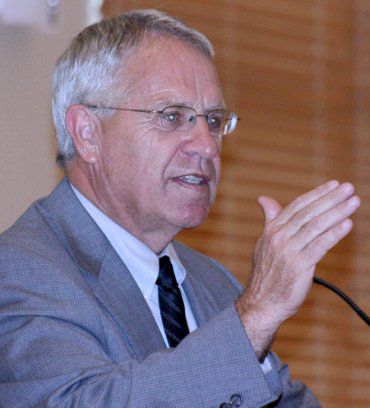A public meeting on Wednesday night concerning the possible merger or partnership between the College of Eastern Utah and Utah State University brought up some serious and interesting questions from audience members.
But the point of the questions and answers could be moot if nothing happens between the two schools. That is up to parties that weren’t present at the meeting.
The meeting was held as a question and answer period featuring CEU Interim President Mike King, USU President Stan Albrecht and USU Provost Ray Coward. And while nothing is a sure thing some of the discussions on that rainy evening could shed light on what a USU/CEU relationship would look like if there were a partnership.
“This meeting is separate from what the Board of Regents are doing,” King told the audience. “They have a task force that will be assembling next Monday to decide how they will be exploring the possibilities. They have complete knowledge of what we are doing here this week and are for it.”
Albrecht said that he realized the conversations they had been having for the last day with community and college staff members seemed a little out of order, because no decision has been made about what might happen, but he felt it was important to talk with everyone and give them information.
“We have not had a real chance to come and meet with the people who are here,” he said. “This was our opportunity to do that.”
The change in the status of CEU can be affected by what the administrations of both schools say, but the ultimate decision comes down to what the Board of Regents recommends to the legislature. Albrecht was asked about a time line concerning such a change and he said he could guess at it but that would be all the answer would be.
“The task force has to make up their minds with their research and then they will recommend what should be done to the Board of Regents,” he said. “Then the Regents will take recommendations to the legislature. That gives us all about a six month time line to figure this out.”
He said once the legislature makes a decision then implementation would start, probably around next spring sometime.
Albrecht mentioned that during the meetings with community leaders on Wednesday one asked what if the area just didn’t want to go along with making any kind of change. He said that no change is unthinkable.
“Everyone is concerned about CEU and what is going on, including the Regents, legislature the governor’s office, everyone,” he said.
All three said change is inevitable. But what that change will be still remains to be seen.
Albrecht and Coward addressed most of the questions from the audience, and many people seemed to come away feeling a little better about USU and what might happen. However, neither Albrecht or Coward will be there forever and many were worried what might happen in the future.
“If my grandkids want to go here in 10 years what will the tuition be like if USU is involved?” asked one audience member.
Albrecht pointed out that even if there wasn’t a a partnership with USU or another kind of change in CEU’s status, things will change anyway because it is taking place throughout higher education in Utah. He suggested that many of the traditions and things that are good about CEU could be protected by a memorandum of understanding should some type of partnership take place.
Coward and Albrecht spent a good portion of the evening talking about their present satellite campus’ and how they work, what services they provide and the success they have had at those locations.
“We have a community college mission within our charter,” said Coward. “Last year we produced more people with associate degrees than CEU did, and some of those came off our main campus in Logan.”
He also pointed out that the main campus has about 14,000 students and that the satellite campus’ are growing rapidly.
“In fact they have almost caught up in enrollment with the main campus. They have about 11,000 students,” he said.
USU has campus’ in Vernal, Brigham City, and Tooele. They also have smaller educational centers in other places in the state.
Asked how CEU would fit in with those operations Albrecht pointed out that CEU is on a different continuum than any of the others.
“CEU is what they all want to be some day,” he said. “You have athletics, campus life, housing on campus, tradition and many other kinds of things they don’t have yet. In many ways CEU is the model for what they would like to become.”
State Representative Christine Watkins was in the audience and pointed out that nothing is a done deal and that the legislature is who will ultimately make the decisions on the ideas that will be forthcoming from the Board of Regents.
“I and David (Hinkins, state senator who lives in Ferron) live in this area and we want to see CEU succeed,” she said. “We will be watching closely what happens. I know that I have been educating people in the legislature about CEU during my first term in office. Many have come to me and said the school is going under. I have corrected them on that and we will be working together for what is best for the area.”
More details concerning the meeting will appear in the Tuesday June 16 issue of the Sun Advocate.
USU/CEU public meeting exposes citizens to USU officials

"Stan Albrecht addresses questions from the audience."
